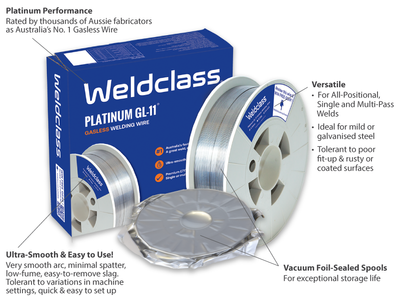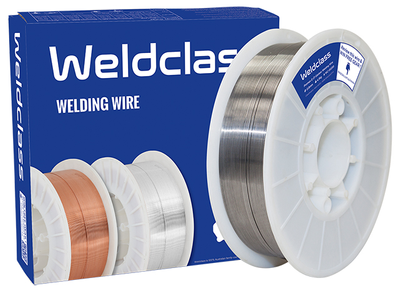Gasless Welding Wire | Gasless MIG Wire


Gasless MIG Wire: If you're welding without gas, the Weldclass gasless (self shielded) wire range has you covered!
Includes the legendary Platinum GL-11, Australia's favourite gasless wire.
For tips and troubleshooting info on gasless welding - click here.
-
Gasless (self-shielded) 'MIG' Welding Wire in 0.9kg (100mm) mini-spools for small welding jobs and use in spool-guns. Weldclass mini spools are E71T-11 grade which is suitable for multi-pass welding - unlike many other mini-spools on the market that are E71T-GS grade & suitable for single-pass welding only.
-
Australia's number one gasless mig wire (self-shielded welding wire) for welding without gas. PLATINUM GL-11® is the first choice of welders across Australia and beyond. Seriously smooth arc, easy-to-use, low spatter, low fume, easy de-slagging, multi-pass and all-positional. Great for mild and galvanised steels. E71T-11 classification. Available in 0.8mm, 0.9mm, 1.2mm, 1.6mm - 4.5kg and 15kg spools.
PLATINUM GL-11® gasless wire is used and reviewed by thousands of Aussie welders every year, with an average rating of 9.67 out of 10. Click 'reviews' tab below to read feedback from other users. -
PROMAX T11 is a premium quality gasless MIG wire offering exceptional user appeal, together with great value. Suitable for both single and multi-pass welding of mild and galvanised steel, in all positions. Smooth arc, low spatter, low fume, and easy to use.
-
PROMAX E-21 is an industrial grade Gasless (self-shielded) 'MIG' welding wire offering great value. E71T-11 classification, suitable for single or multi-pass welding of mild steel including galvanised steel.
What is Gasless MIG wire?
Gasless "MIG" wire is a flux-cored, self-shielded welding wire for use in MIG welding machines. More correctly, gasless wire is a self-shielded FCAW wire (flux cored arc wire). The flux contained within the hollow wire reacts with the welding arc to form a slag and also create a gas shield to protect the weld pool from the atmosphere until it has solidified. (Strictly speaking, the term 'MIG' is not correct since 'MIG' stands for metal inert gas).
Where is Gasless Wire used?
Gasless welding wire is widely used in field and construction work, due to its simplicity and portability – no gas means no more lugging around gas cylinders. Self-shielded wire is also used to reduce costs in non-production work where the cost of gas (and / or the cost of rental) is a significant portion of the overall cost. It is also ideal for outdoor environments where windy conditions would typically cause porosity when using standard MIG wire and gas.
Gasless welding offers relatively high welding speeds and generally has good penetration into the base metal. The flux contained in the wire also acts as a cleaning agent and allows it to be more forgiving of rusty, dirty or contaminated base metals.
The secret to the performance and user appeal of any gasless welding wire is the formula of the flux. This formula is not easy to perfect, and that’s why many welders prefer the tried and tested Weldclass Platinum GL-11 gasless welding wire over other brands.
What are the disadvantages of Gasless MIG welding ?
Gasless welding wire has a couple of disadvantages over gas-shielded wire;
- It typically creates more spatter and fumes
- A flux is formed over the weld which must be chipped off
Having said that, it's important to keep in mind that;
- Weld appearance is often not so critical in the applications where gasless wire is commonly used and...
- There is often a big difference between a top quality gasless wire (like Platinum GL-11) and other more basic alternatives when it comes to spatter levels and how easy the flux is to remove.
Read more about the pros and cons of gasless wire here.
How do I set up my MIG welder for gasless welding?
Here's a quick check list;
- Drive Roller: Mostly knurled drive rollers are used with cored wire, as the wire is softer and ideally requires more fricition as assist feeding. If you don't have immediate access to a knurled roller you can try your standard V-groove rollers; often these will work OK providing the torch is not too long and you can keep the torch cable relatively straight. (Avoid putting too much tension on the drive rollers, this will distort the wire & cause feed problems).
- Polarity: Connect your torch to negative and earth lead to positive. More about how to do this here; Gasless ('MIG') Welding – What is the correct polarity?
What size Gasless wire should I use?
Because self-shielded wire has a flux core, it can't always be directly compared (in terms of material thickness suitability) to solid wire.
This article has some great info on this topic: Gasless ('MIG') Welding of thin section steel - should I use 0.8mm or 0.9mm wire?
How strong is gasless wire?
In terms of tensile strength specifications, common gasless wire (E71T-11 grade) is similiar to ER70S-6 solid wire. Or compared to general-purpose welding rods (E6013), gasless wire has higher tensile strength specification. For more details, see Comparing strength of common welding wires and electrodes.
If there is no gas, there will never be porosity - right?
Not quite! You can exprience porosity with gasless wire under certain conditions - read here to find out what causes it and how to prevent it; Gasless ('MIG') Welding – what causes Porosity and how to fix it
What Is The Purpose Of The Flux Core In Gasless Welding Wire?
One of the main purposes of flux is to shield the weld (in the absence of gas). However, the flux core in gasless 'MIG' welding wire serves a number of purposes during the welding process. These functions are essential to ensure a successful weld without the need for an external shielding gas. Here’s a breakdown of its purposes:
1. Shielding the Weld Pool
The flux core generates a shielding gas (typically carbon dioxide or other protective gases) when it is heated during welding. This gas protects the molten weld pool from atmospheric contamination, such as oxygen, nitrogen, and moisture, which can cause porosity, oxidation, or other weld defects.
2. Slag Formation
The flux core produces slag, a layer of solidified material that covers the weld as it cools. This slag protects the cooling weld metal from oxidation and other atmospheric contaminants. It also slows down the cooling rate, reducing the risk of cracking in the weld.
3. Deoxidation and Purification
Flux contains deoxidizers and scavengers that help remove impurities from the weld pool. These components bond with oxides and other contaminants to form slag, ensuring a cleaner and stronger weld.
4. Stabilizing the Arc
Certain chemicals in the flux help stabilize the electric arc, making it more consistent and easier to control. This improves weld quality and reduces spatter.
5. Alloying
The flux core can contain alloying elements, such as nickel, chromium, or molybdenum, that enhance the mechanical properties, corrosion resistance, or other characteristics of the weld metal
6. Thermal Management
The flux can also help manage the heat distribution during welding, contributing to better penetration and a more uniform weld bead.
In summary, the flux core plays a vital role in ensuring the weld is protected, clean, strong, and stable, making gasless welding wire a versatile and practical choice for many welding applications.
More info on Gasless MIG wire





